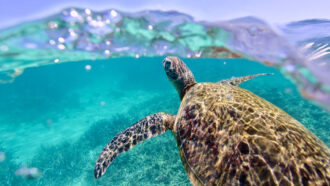Exploring the Mysteries of Pregnant Whale Sharks with Jet Packs and Ultrasounds

How do you know if the world’s largest living fish is expecting babies? Not by her bulging belly, it turns out.
Scientists thought that an enlarged area on the undersides of female whale sharks was a sign of pregnancy. But a technique used for the first time on free-swimming animals showed only skin and muscle. These humps might instead be a secondary sex characteristic on mature females, like breasts on humans, researchers report in the March 23 Endangered Species Research.
The ultrasound is part of a suite of new methods including underwater “jet packs” and blood tests that scientists hope could unlock secrets about this creature’s reproduction.
Whale sharks (Rhincodon typus) are classified as globally endangered by the International Union for Conservation of Nature. There are only an estimated 100,000 to 238,000 individuals left worldwide, which is more than a 50 percent decline in the last 75 years.
In part because whale sharks are relatively rare, their reproductive biology is mostly a mystery (SN: 8/1/22). Nearly everything biologists think they know is based on the examination of one pregnant female caught by a commercial fishing boat in 1995.
“Protecting organisms without knowing about their biology is like trying to catch a fly with our eyes closed,” says Rui Matsumoto, a fisheries biologist with the Okinawa Churashima Foundation in Japan. The organization researches subtropical animals and plants to maintain or improve natural resources in national parks.
To learn more about these gentle giants, Matsumoto and shark biologist Kiyomi Murakumo of Japan’s Okinawa Churaumi Aquarium had to figure out how to keep up with them. Like superheroes in a comic book, the biologists used underwater jet packs — propellers attached to their scuba tanks — to swim alongside the fish, which average 12 meters in length and move about five kilometers per hour.
Then the researchers had to maneuver a 17-kilogram briefcase containing a waterproof ultrasound wand on the undersides of 22 females swimming near the Galápagos Islands and draw blood with syringes from their fins. Until this study, the ultrasound wand had never been used outside of an aquarium on free-swimming wildlife.
Performing these two tests on whale sharks is especially challenging, says study coauthor Simon Pierce, a whale shark ecologist with the Marine Megafauna Foundation, a nonprofit organization that uses research to drive marine conservation. The fish “have some of the thickest skin of any animal — up to about 30 centimeters thick.”
Another challenge is the seawater itself, which can contaminate blood samples. The researchers developed a two-syringe system, where the first syringe creates a vacuum and allows the second syringe to draw only blood.
Get great science journalism, from the most trusted source, delivered to your doorstep.
Back in the lab, the blood plasma from six of the females showed hormone levels similar to levels obtained from a captive immature female in an aquarium, indicating those wild females were not old enough to reproduce.
Ultrasound imagery showed egg follicles in two of the 22 female sharks, meaning those females were mature enough to reproduce but not pregnant. The biologists did not locate a pregnant whale shark.
Pioneering these noninvasive techniques on whale sharks has opened the door to possibly learning more about other endangered marine animals, too. Waterproof ultrasound wands mounted on a pole, Pierce says, are now being used on tiger sharks in places where the predators are drawn in by bait.
Rachel Graham agrees developing these underwater sampling techniques is an “astounding feat.” But the marine conservation scientist and founder of MarAlliance, a marine wildlife conservation nonprofit, doubts whether most free-ranging wild marine animals, particularly faster-swimming sharks or marine mammals, would tolerate similar tests.
“What makes whale sharks fairly unique … is that they move relatively slowly at times, have the ability to remain stationary, and they tolerate the presence of other animals — such as us — nearby,” says Graham, who has studied shark species around the world and was not involved in the new study.
Coupled with satellite tracking, the new methods, could eventually show us where whale sharks give birth, Pierce says. Little is known about whale shark pups, including whether they are born in shallow or deep water, and whether pups are born one-at-a-time or if mothers gather to give birth together. “Assuming they do have some sort of breeding or pelagic nursery area we can identify … then that obviously goes quite a long way towards conserving the population.”
Our mission is to provide accurate, engaging news of science to the public. That mission has never been more important than it is today.
As a nonprofit news organization, we cannot do it without you.
Your support enables us to keep our content free and accessible to the next generation of scientists and engineers. Invest in quality science journalism by donating today.




